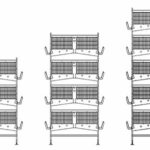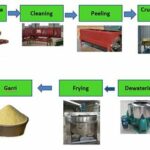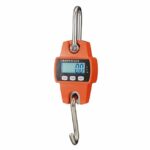In 2020, farmers, especially those in Africa, felt the negative impact of climate change, as there were dramatic changes in rainfall patterns. Consequently, hectares of farmland dried up because about 90% of Nigerian farmers rely only on rainfall to grow their crops. However, a few farmers survived the period because they planned ahead of time by securing an irrigation system on their farms.
Therefore, to ensure farmers enjoy an all-around productivity irrespective of the changes in seasons, Afrimash held a free online in February 2021. At the training, farmers learnt how to prevent the adverse effects of insufficient and uncertain rainfall on agriculture through efficient irrigation systems and management.
Meet the Facilitator: Kenneth Okonkwo, CEO, Irritech Nigeria Ltd
Kenneth Okonkwo is an Agripreneur with over five years of experience in Agribusiness Development and Sustainable Food Systems.
He is the Founder and CEO of IrriTech Nigeria Limited, where he provides low cost and highly efficient Solar Powered Irrigation kits for smallholder farmers.
He holds a Bachelor’s degree in Agricultural Technology from the Federal University of Technology Owerri, a Mini-MBA from Lagos Business School and a Certificate in Social Change Leadership from Staley School of Leadership Studies Kansas State University, USA.

“I tell you from my experience, I’d take up one plot of land that is irrigated than taking five hectares that is unirrigated…I have seen farmers who achieved over 200% productivity and profitability by using Irrigation.”
Kenneth Okonkwo, Founder, Irritech
Kenneth has managed various international and local Agricultural Developmental projects that foster the growth of small-scale Agricultural businesses, such as the United States Consulate Farming for Empowerment and Entrepreneurship Development project and the 2019 German Consulate FEED Project.
He is a United States Consulate Carrington Youth fellow, ONE champion at one.org, a TEDx Johannesburg Fellow, a TFF West Africa ambassador, a Young Innovation Leaders Fellow, a 2019 Africa Future Awards prize for Agriculture Nominee and 2020 winner of the Kingdom of Netherlands Orange Corners Entrepreneurship Innovation Fund.
He is passionate about food security and committed to ensuring a hunger-free world.
At Afrimash free online training, Kenneth discussed the Basics of Irrigation Systems and Water Resources using the following outlines:
- Types of Irrigation
- How to Select the Right Irrigation System
- Drip Irrigation
- Key Parts of Drip Irrigation System
- How to Set up Drip Irrigation System
Types of Irrigation
In simplest terms, irrigation is the artificial application of water to crops when there is no rainfall, and you can achieve this through manual or automated systems. There are three major types of irrigation, and these include:
- Surface Irrigation: This is one of the most common types of Irrigation in Nigeria, especially in the North. It has methods of applying water to the crops like furrow and canals. So in this method, you channel water from a water source into the farm. Surface Irrigation is suitable for crops like rice and some vegetable crops.
- Sub-surface Irrigation: In this method, you apply water directly to crops roots by laying pipes into the soil (underground).
- Overhead/Sprinkler Irrigation: This type of irrigation is commonly used across the world as it is suitable for a wide variety of crops. It is also efficient. Here, you apply water to crops through sprinklers, overhead systems, spray tube, rain gun etc.
Selecting an Irrigation System
Selecting the appropriate type of irrigation depends on so many factors;
- Type and nature of water source (river, borehole, well etc.)
- Type of Crop (vegetable, fruits, tree) and this is a critical area. Not all crops support any irrigation system. You must consider the application timeline, durations and water requirements of such a crop.
- Slope and nature of the land
- Cost
- Soil type
The most effective and reliable irrigation system anyone should go for is Drip Irrigation.
Drip Irrigation
With drip irrigation, the application of water to each plant is separately in small, frequent, precise quantities through dripper emitters. It is the most advanced irrigation method with the highest application efficiency. The water is delivered continuously in drops at the same points, moves into the soil, and wets the root zone vertically by gravity and laterally by capillary action. The planted area is only partially wetted.
Also, drip Irrigation is like passing water to a dehydrated person through the veins rather than pouring it on the body. With drip irrigation, you can be sure that your crops will efficiently utilize water. Most of the water you pass to the base of crops will be used well. There are no run-offs like in other forms of irrigation.
Drip Irrigation System can be used for;
- Fertigation: This is the process of applying fertilizer to the crops through the irrigation system. A drip irrigation system can be used to pass soluble fertilizers to your crops. A farmer can also mix soluble fertilizers like NPK, Mono Ammonium Phosphate, Mono Potassium Phosphate, Calcium Nitrate, Potassium Nitrate, humates like humic acid and fluvic acid and other fertilizers in water and apply to your crops through your drip irrigation system. Fertigators (Venture Injector or Fertilizer Dosing Pump) are used for Fertigation.
- Chemigation: You can send chemicals like pesticides to your soil and the roots of your crops using your drip irrigation system. You can pass Nematicides through the drip irrigation system to your crops. However, you should use no return valves so that the chemicals will not flow back to your source of water.
For organic farmers, you can use drip irrigation pipes to send molasses, fluvic acid and dispersed neem oil to your soil and the roots of your crops. A high dosage of fluvic acid can decontaminate your soil and take out harmful nematodes, ditto molasses and dispersed neem oil. - Biopesticides can also be passed to the soil and crops through drip irrigation. You can also send Microbial inoculants to your crops through this type of irrigation system.
Key Parts of a Drip Irrigation System
- Mainline: This is the pipe that brings water from the source of water.
- Drip tapes: Your drip tapes are the tiny black tapes you lay on your farm, and water drops to each crop through it. It comes in various ways. Some have a spacing of 30cm, others 50cm, some 60cm spacing, to suit your crops spacing need. Some have a thickness of 0.2mm. Others are as thick as 0.4/0.6mm.
- Layflat: Your Layflat supplies water to the drip tapes.
- Drip connectors: This connects the drip tapes to the layflat.
- Puncher: You use this device to create the appropriate hole on the layflat
- Fertigator (Venturi) for fertigation
- End Cap
- Filter
How to Set Up a Drip Irrigation System
In setting up a drip irrigation system, you channel water into the raised tank from the water source and then release it to the crops through the Layflat. It is best to lay this at the part of the farm that is higher in terms of height.

You will then use your puncher to create a hole on your Layflat, depending on the planting distance you are adopting.

Next, is to put your Drip connectors to the Layflat.

Finally, connect your Drip tape to the Layflat through the connector.
This way, you get your system running. The Filter and Venturi will be connected by a good plumber.

Questions
Question: What type of irrigation do I need for crop rotation?
Answer: For crop rotation, it depends on the type of crop you’re growing.
If you are using drip irrigation, go for the drip tapes with 30cm spacing. This allows you to use it on various crop types. Yet, you can achieve a good result with the sprinkler irrigation system
Question: If someone cannot afford to dig a borne hole and well. Can someone use a nearby river as a source of irrigation?
Answer: Yes 100%. You will need a pump to pull water from the river.
Questions: Please I want to know the effects of unclear water on crops?
Answer: Well, some water sources might not be good for Irrigation and this will warrant you to carry out a test to determine the pH level of the water and other chemicals. On the other hand, it is best to avoid water with too much sand, stone, and dirt. These particles enter the drip tapes and block the emitters.
In a nutshell, if you are planning to go into crop production or already into crop production, consider going for irrigation on your farm. Climate change is real and you have to overcome the challenges ahead by getting yourself a good irrigation system on your farm. This gives you the opportunity to produce crops throughout the year and also increase your productivity and profitability.


















2 thoughts on “Why Your Farm Needs An Efficient Irrigation System”
Thanks I have learned a lot about farming
Hello Okwara,
Thank you for reaching out to us. We are glad to know you found the post helpful.
To get more useful tips and updates on our products and offers, kindly subscribe to our newsletter here.
Thank you for choosing Afrimash.